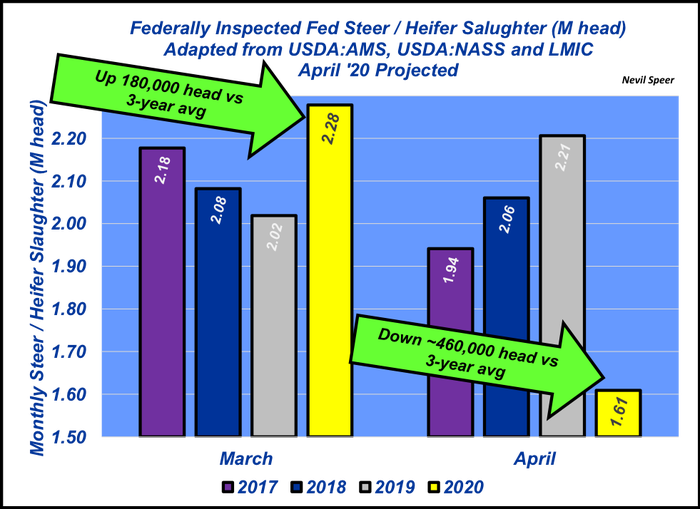April fed steer & heifer slaughter takes a nose-dive
Fed cattle are backing up in feedyards. The implications of that will be long-standing.
May 7, 2020

This column has been featuring the impact of COVID-19 on the beef industry during the past month. The running series has thus far highlighted the following topics:
The final topic featured in last week’s column noted that, “There are less cattle going to slaughter, that means reduced orders for feeder cattle placements to take their place.” Fewer cattle going to slaughter is the focus of this week’s discussion.
The illustration details monthly fed steer and heifer slaughter during March and April over the past several years. COVID didn’t really begin to hit fed cattle throughput until early April. In fact, March slaughter was up versus the previous three-year average.
But then the shutdown began. The fallout has been dramatic. Final numbers still aren’t tallied (actual slaughter numbers run on a two-week delayed reporting cycle from USDA), but the industry will obviously be in a sharp deficit. Clearly, that has huge implications even after we get up back and running full speed.

From a quantitative standpoint, the extra cattle are still in the feedyard and have to be reckoned with – the challenge will be to phase them in along with regular kill. The back-up is challenging just from a standpoint of scale.
However, from a qualitative standpoint, the disparity becomes even more significant. Cattle are not nearly as fungible as hogs or chickens. That is, when a slowdown occurs, there’s going to be some picking and choosing about which cattle get marketed – better cattle get first priority.
The best indicator of that playing out is the record jump in cattle grading Prime in April versus January through March. Generally, it goes the other way - grading percentages seasonally decline as we enter the second quarter.
Putting those two factors together, it represents some marketing challenges within the slaughter mix as we (hopefully) gain some normalcy in the coming month(s). Yet another factor to monitor carefully – stay tuned!
Nevil Speer is based in Bowling Green, Ky. and serves as director of industry relations for Where Food Comes From (WFCF). The views and opinions expressed herein do not necessarily reflect those of WFCF or its shareholders. He can be reached at [email protected]. The opinions of the author are not necessarily those of beefmagazine.com or Farm Progress.
About the Author(s)
You May Also Like





